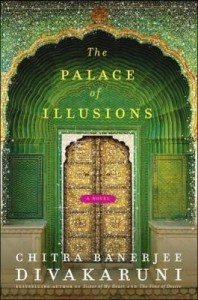Book Review: The palace of illusions
The palace of illusions is the retold of the epic tale Mahabharata through the lens of the lead female character, Paanchali. I believe this book answers all my questions I had towards the patriarchal rule of the Paandavas. According to Mahabharata it is Draupadi who caused the downfall of her own people. Many believe that it was her obstinate actions that brought about the destruction of the Third Age of Man and she is known to be a kritya, one who brings doom to her clan. She is looked upon as the unlucky one, so much so that people don’t even name their daughters Darupadi. I'm glad through her writing the author brings a new light on Paanchali
The author narrates the story in first person, of Panchaali who was born as Draupadi with her twin brother Dhristadryum from the fire. Her fiery pride and bravery that was at the brink of being foolish is what makes the character compellingly likable. The story starts at her ‘birth’ and moves on to the tale of Arjun winning the swayamvara and her being married to all five brothers eventhough she fell in love with Karna when she saw him for the first time in the portrait.She was forced to hide her feelings towards Karna during the swayamwara and didnt allow him to compete in the swayamwara as he is not belonged to the royal blood (Spoiler:later she found out that Karna loves her as well). The title of the novel denotes the name of the actual palace that Paanchali lovingly builds for her five sons and her husbands. Yes, it is a palace made with the help of magic, and undoubtedly is it like no other in the history of time.
The author portrays Paanchali as a powerful, strong, and independent woman, an equal to the men around her rather than subservient. She presents Paanchali’s life as a series of choices made by Paanchali, and not something that has been pushed or forced on her. Thus it gives Paanchali a voice to be heard in the overwhelmingly patriarchal society that was ancient India. The author's narration of the story from Paanchali's point of view which gives a stronger role to the women of the story, and portraying them as equals in society.
Though the focus is on Paanchali’s life, the author is careful to include the stories of the other strong female characters, not just as Paanchali’s rivals, but also as strong role-models (for Panchali and others alike). The author portrays, at length, the story of Kunti, Panchali’s mother-in-law, who devoted her life to the upbringing of her own sons and the sons of her husband’s second wife, making sure to treat them all equally, and grooming them to become kings. She also mentions the story of Gandhari, the wife of the blind king Dhritarashtra, who blindfolds herself at her marriage, choosing to live as an equal to her husband, surrendering her power as a queen and mother. What makes Divakaruni’s novel compelling and different is she portrays the stories of all these women unfolded from the consequences of the conscious choices made by them, not as roles or norms that have been pushed by men or the society. The lives that the female characters lived was something that they choose to live (except for Paanchali as she was forced to have five husbands although she was married to Arjunan only during the swayamwara).
The original epic was about gods, demi-gods, kings, princes, warriors, and other noble men. But the author's interpretation towards the story provides a humanistic touch to the epic, making it more realistic, more relatable, and more personal.Those who wished to read this book, I would recommend to do some research on Mahabaratha and Kurushetra war before you read the book as you need to know whole story.
